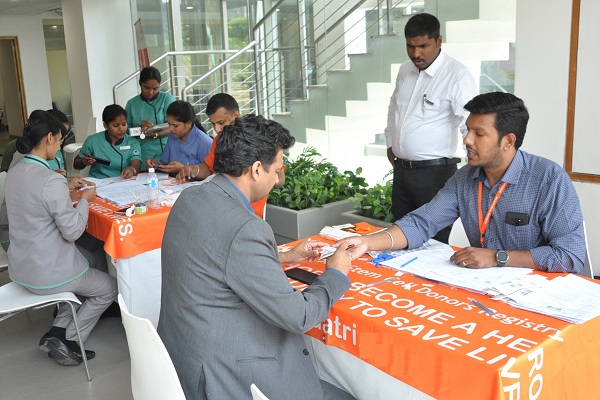
Stem cell transplantation is a critical medical advancement that has significantly improved survival rates in patients fighting life-threatening blood malignancies. Particularly in high risk blood cancers and relapses following chemotherapy, this treatment procedure involving relocation of healthy blood-forming stem cells offers life saving outcomes. Unlike other solid organ transplants, Stem cell transplant is a non-surgical transplant and the process is in-fact similar to blood transfusion.
Stem cell transplantation has the potential to treat thousands of blood cancer patients, however, the success of this application depends on a sustained registry of young and healthy adults who pledge to donate their stem cells and come forward to donate when there is a need.

India has the third highest number of hematological cancers in the world, with around 2.25 lakh cases currently and over 10,000 new cases being registered every year.
Blood malignancies are broadly categorized into three types including leukemia, lymphoma and myeloma. Leukemias are characterized by proliferation of abnormal white blood cells which compromises the immune system and ability to fight infections. Many types of Leukemia are either ‘acute’ or ‘chronic’ based on how they behave. In general, acute conditions develop very quickly and need aggressive treatment right away. Chronic conditions usually progress more slowly and intensive treatment may not be needed straight away.
Lymphoma is a type of blood cancer that affects the lymphatic system, an important part of the immune system and is characterized by uncontrolled proliferation of lymphocytes, a kind of white blood cells. Lymphoma can develop in many parts of the body, including the lymph nodes, bone marrow, blood, spleen and other organs. There are two main types of lymphoma- Hodgkins and Non-Hodgkins Lymphoma, based on how they behave and their treatment. Myeloma (also referred to as multiple myeloma) is a blood cancer that affects a certain type of white blood cell called a plasma cell. These cells are made in the bone marrow and produce antibodies which help fight infection.

Also read: Rajiv Gandhi Cancer Institute & Research Center organised its 13th Inter. Conference on Lymphoma
The diagnosis and detection of the type of cancer involves blood tests, peripheral smear examination and bone marrow testing.
The treatment for blood cancer depends on the type of cancer, age, how fast the cancer is progressing, where the cancer has spread and other factors. Chemotherapy involves use of anticancer drugs designed to interfere with and stop the growth of cancer cells in the body. Radiation therapy may be used to destroy cancer cells or to relieve pain or discomfort.
In the case of high risk and aggressive blood cancers stem cell transplantation is the only life saving intervention (known to increase survival rates by 50-60%). Depending upon the condition, some patients with blood cancers are advised transplant upfront, immediately after chemotherapy, while transplant is usually reserved for relapse in other patients, especially those with chronic diseases. Acute Leukemias need allogeneic stem cell transplant where donor is somebody else, while lymphomas and myeloma usually undergo autologous transplant where stem cells are collected from the patient itself, and reinfused after giving high dose chemotherapy.
Stem cells are the body’s primary cells. All other cells, tissue, organs and bones develop from stem cells. Stem cells may be collected from the bone marrow (bone marrow transplant) or circulating blood (peripheral blood transplant). For 90% of donations, stem cells are collected through the latter procedure[i]. This involves passing the donated blood through a small tube into a machine that collects the stem cells, and then returning the rest of the blood to the body. This is a very similar experience to giving blood but takes a little longer. For the remaining 10% of donations, the stem cells are collected from the donor’s bone marrow. It involves a small surgical procedure, using a needle to collect bone marrow from the donor’s pelvis under general anesthesia.
Also read: India has 2,760 licensed blood banks
Research shows that younger donors (between the age of 18 and 40) provide better outcomes for patients, therefore it is imperative that young and healthy adults are sensitized to donate their stem cells. Even though, a donor closely matched to the recipient provides the best possible chance of overcoming the condition, an unrelated donor can be a successful match for a transplant. A patient only has a 25% chance of finding a donor from within the family. Majority of the patients have to depend on unrelated blood stem cell donors.
Even though stem cell donation can cause some minor inconvenience to the donor such as the requirement to complete registration formalities including a simple inner cheek swab test called Human Leucocyte Antigen (HLA) typing, a few hours of the donor’s time and a bit of discomfort. A transplant means a cure, or a new lease of life for someone who is battling a fatal blood malignancy. Understandably, donors experience immense joy in gifting their stem cells when they realize they are in fact gifting a new life to someone suffering terminally. There are about 6 lakhs voluntary stem cell donors registered with various stem cell registries. However, this number is quite inadequate considering a population of 130 crores. Therefore, it is crucial that young, healthy Indians come forward and pledge for donating their stem cells to save the lives of the thousands dying of these dreaded blood conditions.
(Disclaimer: The writer is Dr Prathamesh Kulkarni, Consultant, Bone Marrow Transplant, Nanavati Super Specialty Hospital. Views expressed are a personal opinion.)
Be a part of Elets Collaborative Initiatives. Join Us for Upcoming Events and explore business opportunities. Like us on Facebook , connect with us on LinkedIn and follow us on Twitter , Instagram.












